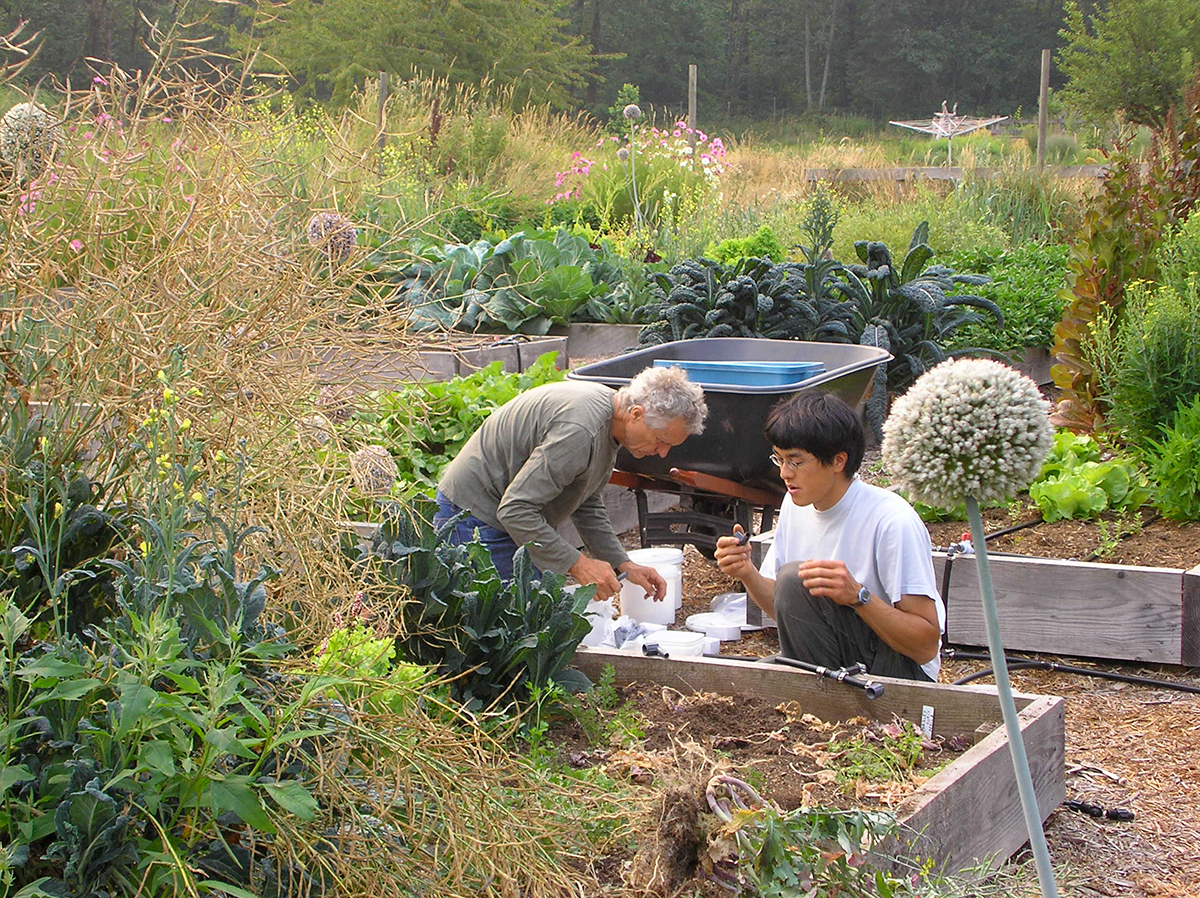Published in the newsletter of The Canadian Horticulture Therapy Association, summer 2016. http://www.chta.ca

What are the goals of Gardens without Borders?
Gardens without Borders is a federally registered not-for-profit that was founded 10 years ago to deliver horticultural therapy programs. Over the years, we have assisted numerous seniors, adults with developmental delays, children with Asperger’s and autism and many other folks who have enjoyed the gardens and the farm environment. More recently, GwB has expanded to take on the running of the botanic garden at Innisfree Farm. We are a seven-acre site specializing in food and medicinal plants. We teach people how to grow, harvest and prepare their own remedies, and how to cook and appreciate farm-fresh foods. We want to empower people in food and medicine security by teaching them practical skills.
How do the gardens at Innisfree Farm offer a therapeutic environment?
For some participants it is simply the opportunity to be outdoors in a tranquil place with no traffic or other human sounds, just the wind in the trees and the birds singing. Walking the labyrinth, smelling the roses, sitting by the pond—all of these offer the chance to slow down, unwind a bit and let go of stress and tension. Others need a structured program with planned activities such as picking and pressing flowers, planting a container garden to take home, making nature art and so on. Still others are able to work in the garden beds alongside our interns and volunteers, share our community lunch, and benefit from the physical activities, camaraderie and sense of contributing to the community at the farm. We customize the garden offerings to suit each individual.
What’s the relationship between horticultural therapy and herbal medicine?
HT is herbal medicine come to life! They are like two sides of the same coin. When I was in graduate school doing my masters of science in herbal medicine at the University of Wales, I did my thesis on quality of life parameters for long term breast cancer survivors who had used herbal medicine. It required advanced statistical analysis and lots of abstract reasoning, and although I was documenting some profound healing from the herbs, I also realized that the tinctures, capsules and pills used had done nothing to deepen their relationship with nature or the ultimate source of their healing. Perhaps I could say that the herbal medicine I was studying and practicing felt unconnected to the actual plants. That’s when I had a sort of epiphany—one of those bolts from the blue that are often a good idea and always disruptive, an intuition that more or less told me to re-focus my work from product to plant, from clinic to garden. I immediately enrolled in the HT program with Christine Pollard at Providence Farm and have been working on the amalgamation and integration of the two practices ever since. So the relationship for me, in my practice, is completely fluid; they are useful, effective and valuable.
One of the unspoken and unofficial but nonetheless critical roles of the herbalist is to strengthen people’s relationship with nature, to assist them in connecting to the greater whole and to understand their own roles and responsibilities in the natural order. By deepening a patient’s appreciation of and concern for nature the patient receives healing on a very deep and profound level, far beyond chemical constituents or carefully constructed formulas.
How can horticultural therapists use herbal medicine for the benefit of their clients?
Aromatherapy can be introduced in subtle ways such as a sprig of herb to wear in a lapel or breast pocket: lavender for someone who is agitated, rosemary for someone who is forgetful, rose or geranium for someone who is sad, mint for someone who is lethargic. Every patient in my practice gets a herbal tea to drink to help reinforce the connection to the actual plants, not just extracts and potions, but the actual flowers, roots, barks and leaves, and it deepens their appreciation of nature. Although I prescribe therapeutic blends, it’s easy for anyone who is not a trained herbalist to use herbs safely and effectively in these ways.
Another simple HT program might involve growing plants and herbs such as lemon balm, peppermint, bee balm, linden, anise hyssop, rose petals and so on, that are easy to grow, taste great and that pose no risk when consumed as a pleasurable tea or tisane.
Taking HT participants on herb walks might also be an option. Depending on the training of the horticulture therapist, whether they have studied anything about herbs or plants as well, it might be as simple as trying to find five yellow flowers or searching for wild berries or mushrooms—to look at, not to eat!—or identifying medicinal plants in gardens, woods and parks.
Another great HT activity is to make natural skin care products or natural household cleaning products. Using healthy ingredients and essential oils—a little goes a long way—people can make something healthy and useful.
What is most satisfying about what you do?
On a professional level, obviously it is when patients get better, when they don’t need me anymore. But on a personal level, my happiest times are when I’m working in the gardens. Obviously, I am benefiting from the horticultural therapy going on here too.
Any final thoughts?
As much as HT is a natural corollary to herbal medicine, so the reverse is also true. If horticultural therapists want a profession, a career, a vocation, of healing with plants then they might want to consider training to become a professional clinical herbalist. The two disciplines are inextricably interwoven and mutually complementary.
